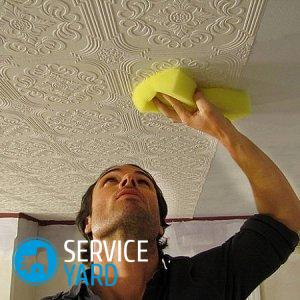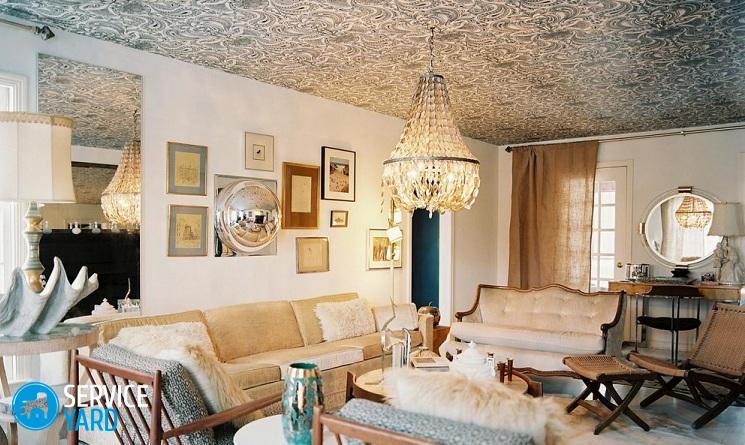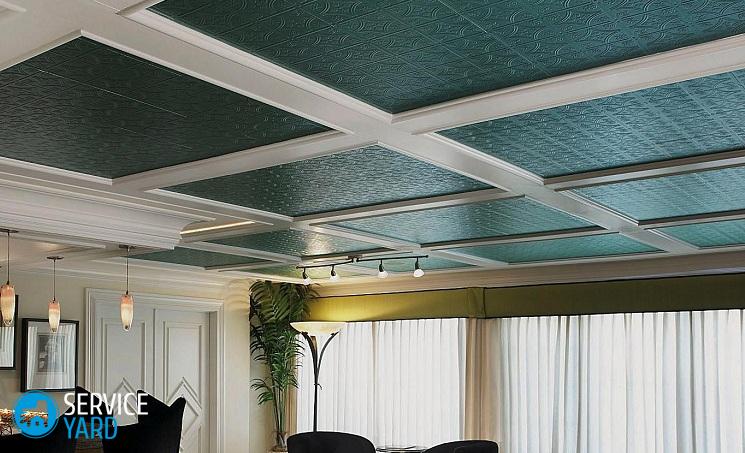Wallpaper on the ceiling for painting

A beautiful even ceiling - if not half the repair, then, in any case, a very significant part. Interior designers offer a lot of ways to decorate the upper part of the room. One of the most modern - wallpapering followed by painting. You will learn from the article what the wallpaper on the ceiling for painting is.
to contents ↑Unusual solution
The main advantage that the owners of the apartment provide ceiling wallpaper for painting is the ability to fully display design abilities. The color can be any, the texture - too, and nothing prevents to make an original ceiling with a painting or even a plot picture, in the manner of a ceiling in an old palace.
But this finish option has other advantages:
- the assortment of wallpapers is very large, and you can find pretty cheap, but at the same time, high-quality and suitable for your chosen style;
- absolutely any color scheme becomes available to you;
- You can choose a very interesting texture that will give your interior a special charm;
- you don’t need complicated expensive tools - you need a fairly ordinary building kit;
- you can do everything yourself without contacting a repair company, and this significantly reduces the estimate;
- the height of the room will remain the same, while stretch ceilings absorb precious centimeters;
- it is possible to paste over the ceiling and walls with the same material, while the seams are masked with paint.
Types of Wallpaper
Painting the wallpaper on the ceiling is the second thing, and the first is pasting. And, of course, we must choose what to glue. In principle, almost all wallpapers are suitable for the ceiling - except, perhaps, for fabric, because they can be too heavy. So what do you want to see on your ceiling?
The following types of wallpaper are suitable for painting for the ceiling:
- paper:
- non-woven;
- cullet.
Paper
The easiest option is to cover the ceiling with paper. Therefore, if you are seriously considering how to glue the wallpaper for painting on the ceiling, be sure to go to the shelves with paper rolls. You will find a ton of varieties. But not all are suitable. If you are going to paint, better refuse:
- from too dark canvases;
- from paper with a bright large pattern.
Light paintings without a picture, with a beautiful texture, are suitable for you. In this case, it is very important to know what condition your ceiling is in. If it is almost perfectly even, single-layer, cheapest ones will do. By the way, they weigh less, and in this case it is important. But for a surface that did not level out, a thin coating is not suitable, so look at two-layer ones. It is not difficult to find them, mainly now they are produced. They are denser and thicker, but also do not weigh much.
Important! For the ceiling, you need to choose wallpaper with water-repellent impregnation, which can be painted several times.
Coarse fiber wallpaper
They are also made of paper. This is a relatively new type of material, designed specifically for painting. The technology used in their production is not the same as in the manufacture of conventional ones. To get a beautiful texture, the canvas is placed between two layers of wood shavings. The grain depends on the fraction of sawdust. The relief pattern on ordinary paper wallpaper is obtained by embossing.
Non-woven wallpaper for painting on the ceiling
An excellent answer to the question of how to paint the wallpaper on the ceiling gives a non-woven coating. They are light but quite dense. The relief surface is formed due to the fact that vinyl is sprayed onto the coating according to the stencil, while the wrong side remains completely flat.
Non-woven wallpaper has a lot of undeniable advantages:
- do not grind the surface too carefully - minor imperfections will not be visible;
- glue is applied to the ceiling, and not to the wallpaper - it is much more convenient;
- the material is very durable and lasts remarkably long, and you can repaint as many times as you like;
- if a crack forms, the interlining will not allow it to creep.
Important! But not all non-woven wallpapers are suitable for painting. It is better if there is not much foamed vinyl on them - it is very easily scraped off, and accordingly, the paint will also crumble.
Cullet
Cullets are made of fiberglass, dolomite, lime and quartz sand. In the process of joining the paper base. They have a lot of their positive properties:
- unevenness of the ceiling will not be visible;
- if a fire breaks out in the apartment, such a coating will definitely not catch fire;
- various interweaving fibers provide a very interesting pattern.
Of course, the question may arise, how to paint the wallpaper on the ceiling. But you will get an answer to it at the nearest hardware store, because paint is also available for such a coating.
to contents ↑Cooking surface
Despite the fact that many types of wallpaper conceal irregularities, the surface is still better to prepare. She must be:
- durable;
- without noticeable flaws - potholes or ledges;
- as clean as possible.
In order to keep the wallpaper on the ceiling well, you will need:
- putty;
- primer;
- a set of tools - spatulas, brushes.
Here is an approximate amount of upcoming work:
- Before starting repairs, remove everything that is possible from the room - furniture, household appliances, etc.
- Cover what cannot be removed with plastic wrap (it is best to fix it with tape).
- The first thing to do when undertaking the repair of the ceiling is to remove the old coating, if it is, of course, removed.
- Inspect your ceiling for overly noticeable holes. It is useful to tap the surface for peeling fragments.
- If there are large flaws, putty them, and then level the surface. It does not have to be perfect, but any wallpaper is better to glue on a flat plane.
- Cover the ceiling with a deep penetration primer - this is usually done in two layers, and the first should be allowed to dry well.
to contents ↑Important! The primer must be selected neutral tones.
Determine the size
Any repair begins with determining the scope of work and the quantity of materials. Determine the surface area to be glued - in a rectangular or square room it is quite simple to do this, it is enough to multiply the length and width. If there is a niche, its area is added, if the ledge is subtracted.
As for the size of the wallpaper, the ceiling is somewhat different from the wall. They are a little wider. In the store you can find, for example, the following options:
- 10x0.53;
- 10x1.06;
- 25x1.06;
- 125x0.75;
- 17x0.53.
to contents ↑Important! But these are just some examples, there are other standards. Large length and width allow you to do without joints. In addition, there are practically no scraps left. You are unlikely to need a canvas longer than 100 m - this option is more suitable for industrial premises, where ceiling gluing is also used. For a room in an ordinary apartment, even 10 m with a width of 1.06 m is enough.
Glue
Wallpaper will not just hold on naturally, of course. Need special glue - for paper or non-woven, depending on what you have chosen. About how to breed it, you will learn from the instructions.
to contents ↑Important! Please note that diluted glue is stored poorly, so you need to do it so much that it is enough for once. However, it is better to immediately paste over the entire ceiling in at least one room.
Instruments
In addition to the wallpaper and glue themselves, you will need some tools. There is nothing special about this set - you will find everything you need in a hardware or hardware store. You need:
- pinch roller;
- roller with a pile;
- paint tray or basin (dip the roller);
- brush (apply glue to the corners);
- mounting knife;
- wide spatula;
- scissors;
- angle (corresponds to the width of the roll, you can make it yourself);
- roulette;
- pencil;
- 2 stepladders.
to contents ↑Important! It is better to glue the wallpaper together, which is why two stepladders are needed. They must be sustainable - safety must never be forgotten.
It's time to glue the wallpaper on the ceiling for painting
Gluing the ceiling seems uncomfortable to many - it’s not pleasant if the greased canvas separates and sticks around the master himself and everything around him. To avoid this, use a simple algorithm. To start, carefully read the instructions for the glue - most often it is applied to the wallpaper, but it happens that the ceiling or both.
If the glue is applied to the wallpaper, the case is as follows:
- Make a marking - apply several longitudinal lines, the distance between them is equal to the width of the roll.
- Cut the wallpaper - the length of each piece is equal to the length of the wall, plus 10-15 cm.
- Apply a layer of glue to the middle of the panel - this is done with a brush.
- Spread the composition evenly with the same brush so that there are no gaps.
- Fold the canvas with an accordion in steps of 30 cm or so - the oiled sides should touch.
- Start pasting from the edge of the wall.
- Hold the folded cloth with one hand.
- Glue it with a second hand and smooth it.
- Gradually spreading the accordion, move along the wall.
- After the first sheet is pasted, proceed to the next strip.
- The second strip is glued in the same way, however, it should be placed strictly butt, while the panels should not go on top of each other.
- Each panel do not forget how to straighten, for which the roller or wallpaper brush serves.
- Eliminate the bubbles in time - while the wallpaper is wet, it’s easy to smooth it, and with the dry ones, there will be much more trouble.
- Once all the strips are in place, remove excess around the perimeter.
to contents ↑Important! In some cases, you need to apply one coat of glue, wait five minutes, and then apply a second, so be careful.
Painting ceiling wallpaper
After the wallpaper is pasted, the following question arises: how to paint the wallpaper for painting on the ceiling? Most popular options:
- acrylic based paints;
- latex based paints;
- water emulsion and water dispersion compositions.
Acrylic is easier to use, and their choice in construction stores is simply huge. They are not particularly expensive. Latex will cost more, but if you want to emphasize a beautiful relief - you will not find better material.
Water-based paint to this day does not go out of use. It is inexpensive, but the choice in stores is limited. However, you can always buy white paint and add color to the desired tone. There is, however, one subtlety - the paint must be very diluted, and directly on the surface, and in the case of the ceiling, this is not always convenient.
to contents ↑How to paint?
There are two ways to paint the ceiling:
- traditional;
- modern.
Traditional
The traditional way of coloring the wallpaper is not much different from the one used by our grandparents. Well, except that nothing is needed to level and ground. The procedure is as follows:
- Paint on the brush.
- Paint over the corners.
- Paint the joints of the ceiling and walls.
- Paint the rest of the surface with a roller, making strokes parallel to the wall on which the window is located.
- Let the paint dry.
- Apply a second coat with transverse strokes.
How to work with a roller?
If you first started repair, this question will surely interest you. In addition to the roller, you will need something else large and flat - painters usually use a special tray:
- Dip the roller in the paint.
- Roll it over the tray several times to remove excess paint.
- Roll the composition over the surface of the ceiling.
Important! Apply paint quickly to avoid bumps and sagging.
Modern way
The traditional method is mainly used for paper wallpaper, as well as fiberglass. With non-woven canvases, you can do otherwise:
- Paint the ceiling in the usual way, that is, first the corners, then the perimeter, and then in two layers - the entire surface.
- Glue the wallpaper.
to contents ↑Important! This option is especially good for textured wallpapers. The background is colored, the relief elements remain white and seem to protrude above the surface, thus giving volume.
Stock footage
In a word, there are a lot of design options for the ceiling. Wallpapering - only one of them, interesting and quite promising. Properly choosing the materials and calculating everything properly, you will cope with this task, even if for the time being you feel like an amateur.
- How to choose a vacuum cleaner taking into account the characteristics of the house and coatings?
- What to look for when choosing a water delivery
- How to quickly create comfort at home - tips for housewives
- How to choose the perfect TV - useful tips
- What to look for when choosing blinds
- What should be running shoes?
- What useful things can you buy in a hardware store
- Iphone 11 pro max review
- Than iPhone is better than Android smartphones





